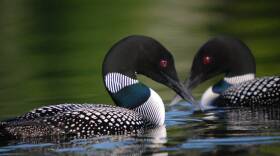What happens to otters in winter when the lake is frozen, I wondered. Does the family stay together or disperse? Do otters have any special survival strategies to get through the cold times?
It was a cool, clear day in September when I peered around the willows and saw the family of five otters lying on the boat dock, sunning themselves. They were lying side by side, with an occasional leg or forearm draped over one another's bodies. We had seen this group of otters several times during the summer, swimming along the edge of the lake.
Their swim is silent and gliding. They seem to roll through the water, surfacing and submerging in a series of dolphin-like arcs. They slip underwater with hardly a ripple, then emerge again to swim silently on.
On that September day, one of the group finally spotted me and lifted up its head with a quizzical look on its face. Although river otters are an overall rich brown color, their faces are lighter, almost like a mask. The otter lowered its head and resumed its snooze, apparently feeling it had nothing to fear from me.
A crisp breeze was blowing. Winter was not far away.
Otters survive the winter by changing their behavior and taking advantage of their incredible fur. In warmer weather, otters spend time in sociable pursuits. They preen or comb each other's fur, frolic in the water, teach the young cubs to swim, toss bits of food to each other, dive to retrieve food in the water, and slide down stream banks. They are well known for their sliding behavior, with one otter pushing off down the slope to be followed by the rest of the family, one by one.
In winter, though, otters become solitary and nomadic. Food shortages force them to forage individually and cover a lot of territory in their search for sustenance, primarily fish, especially in the winter when such summer delicacies as insects, crayfish and amphibians are not available. Otters that normally live in lakes or reservoirs in the summer swim up feeder streams where the water stays open for winter. There they can catch small fish and other aquatic life.
In moving around their territories, otters tend to use many temporary shelters rather than one central den site as they have in summer. One otter that was tracked by researchers was found to use 88 different resting places in a 16 month period. As they hunt for food, otters have to be very mobile.
On bare ground, they have a slow, awkward gait. But in soft snow, they travel quickly in long glides on their bellies and often strike off for several miles across country to another stream or lake. They may travel up one stream, go across country, and then down another drainage. In fact, the need for access to both water and land shelter is so critical that these features limit the number of otters that can live in a region.
Otters sometimes use their slides to shoot them out into ice-free areas created by faster moving water near the center of the stream. An otter can swim away under the ice, perhaps coming up nearly a quarter of a mile away. They can submerge for as long as four minutes and also make use of the small air pockets sometimes trapped between the water surface and the ice covering.
To withstand exposure to cold as they move overland in search of food, as well as to recover from cold-water immersion several times a day, otters depend on superior insulation. River otter fur is comparable to that of the northern fur seal and is about four times denser than muskrat fur.
The wavy hairs of the dense underfur form air spaces, which help prevent contact between the cold water and the otter's skin. Otters take good care of their fur. They are often seen rolling, shaking, and fluffing or preening their hair to restore trapped air after being in the water.
Their thick, insulating fur and their nomadic nature in winter assure the otter's winter survival. As winter closes in and the lake freezes over, I wonder where my otters have gone to spend the cold months. I hope I'll see them again next spring.
'Field Notes' is produced by the Montana Natural History Center.
(Broadcast: "Field Notes," 2/18/20 and 2/21/20. Listen weekly on the radio Tuesdays and Fridays at 4:54 p.m., or via podcast.)





